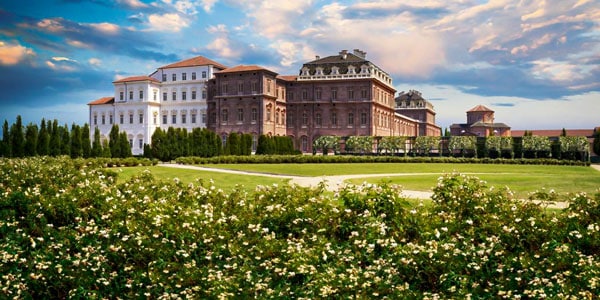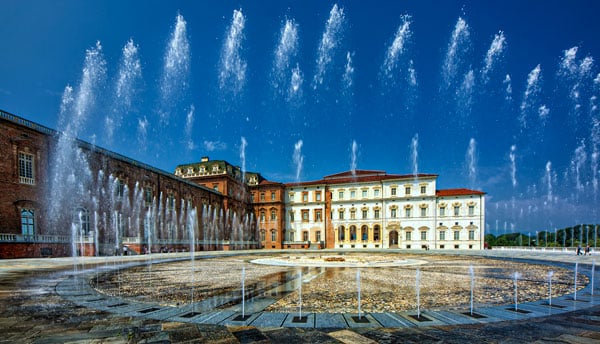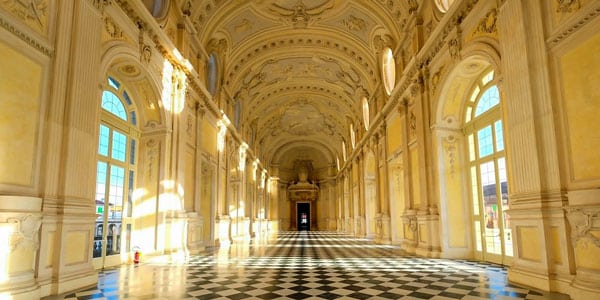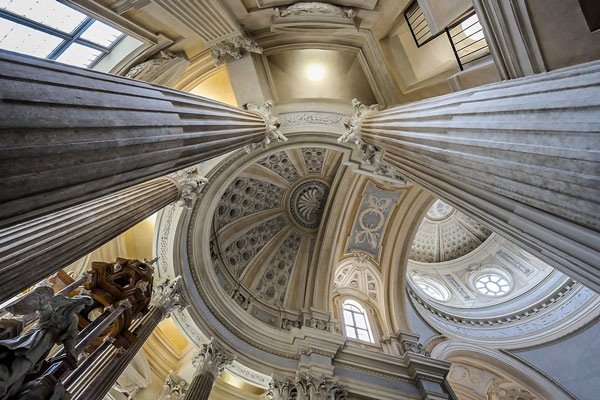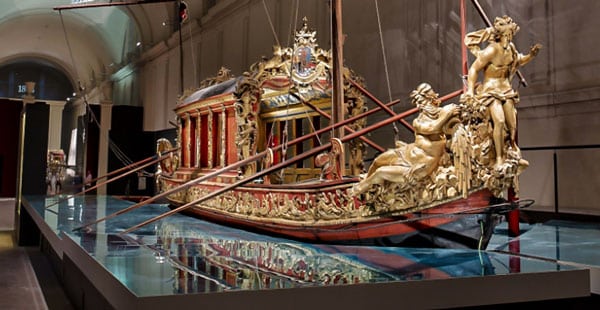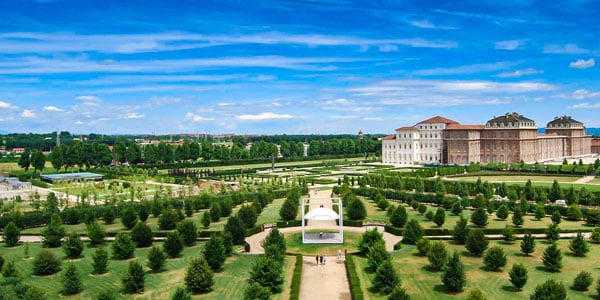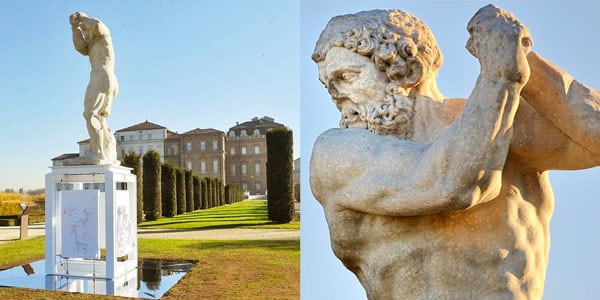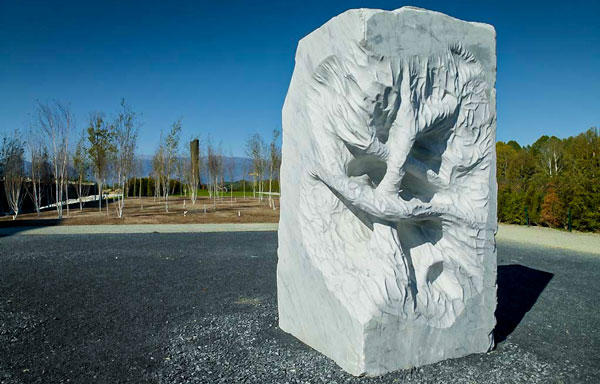The Royal Palace of Reggia di Venaria Reale stands as a unique monument of history, architecture, and landscape design in Italy, notable among the world’s largest palace complexes. It is part of the Savoy Residences (Residenze sabaude di Torino e dintorni), a group of palaces located in Turin and its surroundings.
These palaces rightfully hold their distinguished place among the other 55 sites included in UNESCO’s World Heritage List within the territory of the Italian Republic.
Page Contents
History of the Royal Palace in Turin
Turin is considered one of the largest and most beautiful cities in northern Italy, with its history dating back to its first mention in the 3rd century BCE. The city experienced significant growth and prosperity starting from the 16th century. As a result of various political and military events, Turin became the capital of the Duchy of Savoy and the long-standing residence of the royal family of Italy (the House of Savoy ruled from the 16th century until the end of World War II). During this time, extensive construction took place both within the city and its surroundings.
Construction
Numerous luxurious country residences, hunting lodges, gardens, and parks were built in the rural areas at the foothills of the Alps, serving as expressions of luxury and power of the ruling dynasty.
Among these landmarks, the Royal Palace of Venaria is one of the primary residences of the House of Savoy in Piedmont. The location for its construction was chosen along the ancient settlement of Venaria. The architects’ choice influenced the views of the Alpine mountains, the proximity to rich forests teeming with game, and the captivating expanse of open fields.
The construction of the palace-park complex began during the rule of Duke Carlo Emanuele II of Savoy in 1658 and continued for 21 years. The Duke enlisted court architects Carlo di Castelmonte and Amedeo di Castellamonte for the design and construction of the complex.
Later, starting in 1699, under the orders of Duke Carlo Emanuele II’s son, Vittorio Amedeo II, architect Michelangelo Garove contributed to altering the palace’s design. The garden, originally laid out in the Italian style, gained the layout and features of a French garden.
Decline and Revival of Royal Palace in Turin
During the first half of the 17th century, successive House of Savoy representatives continued the palace complex’s construction and improvement: new halls and galleries were built, valuable works of art were acquired, and the landscape of the area was constantly renewed with new projects.
Architects Filippo Juvarra and Benedetto Alfieri played a significant role in the renovation work. The unique splendor of the royal palace was captured in engravings of that time: a beautiful garden with terraces, grand ceremonial staircases, cascades of fountains, and a grand architectural ensemble.
The decline of the palace complex began in 1706 with the invasion of French armies into Italy. The French Empire repeatedly annexed the northern lands of Italy.
Napoleon’s military campaigns in Italy, lasting until 1814, inflicted irreparable damage on the Venaria Palace: the residence’s gardens fell into neglect (converted into military training grounds), magnificent halls were used as barracks, and the walls of the buildings and architectural decorations were damaged. The actions of vandals also went unpunished. The uniqueness and luxury of the palace complex were destroyed.
After Napoleon’s exile, the Royal Palace remained under Italian military control until 1978, when the Italian Ministry of Culture purchased it.
Restoration work on the palace complex began in 1998, with the main part completed in 2007 with a grand opening. Simultaneously, the nearby La Mandria Park was also restored as part of the restoration efforts and is also included in the UNESCO World Heritage List.
Millions of tourists have had the opportunity to discover a new piece of Italy with French charm. Since its opening, this cultural site has been among the top five most visited attractions in Italy. The reconstruction of the palace and the park ensemble was made possible through a major project involving national and European funding totaling more than €280 million. The work on improvement and restoration continues to the present day.
Description of Royal Palace in Turin
The modern appearance that the Venaria Palace has today was acquired after its last reconstruction in 1739 during the reign of King Carlo Emanuele III. Architect Benedetto Alfieri’s plan to alter the palace’s interior space was successfully realized through the creation of gallery systems by connecting certain sections of the building, expanding the stables, and constructing auxiliary buildings.
To fully appreciate the genius of the creators, one must view the composition of the palace and the landscape as a unified architectural complex. The breathtaking perspectives against the backdrop of the snowy Alps can be best enjoyed from an elevated vantage point, such as the windows of the palace’s upper floors – a truly impressive sight!
Architecture and Style
The Royal Palace itself, as an architectural entity, is a monumental example of 17th and 18th-century Baroque, characterized by the display of luxury and grandeur. Architectural structures of this style were designed to amaze and astonish with their appearance. A characteristic of Baroque buildings is their expressive façade compositions, contrasts, large and voluminous decorative elements, and curvilinear forms.
Upon entering the complex’s parade courtyard, the Diana Palace’s main structure rises. Its central facades are strikingly contrasting in color scheme. The main part of the palace features a white plastered façade, preserved since the 17th century, adorned with traditional Baroque decorations such as shells, fruits, and horns of abundance.
Another part of the building retains its original red brickwork from the 16th century and is more restrained in style. On the left side of the palace, two symmetrical towers with mansards are situated, their walls covered in multi-colored tiles.
Halls
The palace boasts over 50 halls. With numerous family members, guests, servants, and guards of the rulers, there was ample space for everyone. The interior of the halls features antique furniture, clocks, chandeliers, paintings, and tapestries. The walls of most halls are adorned with decorative fabric. Within the palace, several stylishly designed bedrooms are situated, each decorated in varying color palettes.
The permanent exhibition showcases over 4,000 paintings by artists such as Vittorio Amedeo Cignaroli, Pietro Domenico Olivero, Bernadino Quadri, and others. These paintings are accompanied by ancient frescoes depicting hunting scenes, occasionally fantastically intricate (covering an area of over 1,500 square meters).
Some halls present a video installation of the film “Populating the Castles of Venaria Reale” by Peter John Greenaway, comprising 200 independent scenes from the castle’s life.
It’s worth remembering that the palace served as a royal hunting residence, and its exterior and interior décor were largely dedicated to the theme of hunting.
In honor of the ancient Roman goddess Diana, the patroness of hunting, the main building of the complex was named the Diana Palace. Additionally, one of the grandest and largest chambers within the palace is the Diana Hall.
The Diana Hall, situated at the heart of the palace, was where numerous banquets and balls were held during the hunting season. While the palace’s external architecture can be attributed to a subdued Baroque style, the central hall boasted a distinctly lavish Baroque style. The vault of the quadrangular hall is richly adorned with ornamentation, reliefs, and marvelous frescoes by the court Flemish artist Jan Miel, who was working in Italy at the time.
The frescoes draw on mythology from Ancient Greece, depicting Olympian gods, including Diana, of course. Jan Miel’s brushwork is also evident in ten paintings located in the lower level of the interior, all centered around the theme of hunting. The hall’s centerpiece features elaborate equestrian portraits of the Savoy dynasty dukes, created at different times by court artists, lending an air of solemnity to the Diana Hall.
Diana Gallery
The most unforgettable and vivid impression is made by the Grand Gallery, later named the “Diana Gallery.” It connects the two towers on the left side of the palace complex, which once housed the apartments of the king and his heir, and was intended for leisurely strolls.
The gallery spans 80 meters in length, 12 meters in width, and the vaults reach a height of 15 meters. The contrast between the marble floor, laid with black-and-white tiles in a checkered pattern, and the snowy white walls and vaults accentuates the airy space and harmony of proportions. An ingenious solution by architect Filippo Juvarra, who designed the gallery during the palace’s reconstruction, involved the creation of numerous windows: 44 large ones and 22 small ones. They fill the entire gallery with abundant natural light.
The lavish decoration of the windows, ceiling, and two exedras (semicircular deep niches near the entrance) evokes a sense of grandeur.
As visitors explore the Diana Gallery, they are accompanied by the gentle, enchanting music composed specifically for it by Brian Eno.
Sant’Uberto Chapel
The Sant’Uberto Chapel (Cappella di Sant’Uberto) is another masterpiece by the architect Filippo Juvarra and is no less remarkable than the Diana Gallery. Built between 1716 and 1729 by the order of Vittorio Amedeo II, it’s dedicated to the patron saint of hunting.
The chapel adheres to the religious canons of the time with its complex Greek cross layout, multiple altars, stained glass windows, and sculptural compositions. In the central niches, statues of Saint Augustine, Saint John Chrysostom, Saint Ambrose, and Saint Anastasia stand. During sacred masses, members of the royal family occupied the balconies.
Its centerpiece is the main marble altar, a creation of the sculptor Giovanni Baratta from the renowned Baratta family known for their Baroque-style garden, park, and church sculptures. The composition, space, play of light, and sculptures are ingeniously conceived. Observing the main altar positioned between two columns of the apse, it appears to levitate weightlessly in the air behind the benefactress, surrounded by charming marble angels.
For the frescoes, the artist Giovanni Antonio Gallari employed a complex optical illusion technique.
Juvarra’s Stables
Hunting and the royal family’s status required the upkeep of a substantial number of horses of noble breeds. The size of Juvarra’s stables within the palace complex matches that of the Royal Palace. These massive structures, designed in the Baroque style, form a long sequence of buildings with towering arched ceilings. They housed horses and accommodated carriages.
The stables have been well-preserved. Presently, they house horse replicas, carriages once owned by the Savoy dynasty in the 18th and 19th centuries, and historical coachmen’s costumes. The lavish adornments of royal horse stables have been meticulously restored and showcased: harnesses, bridles, horse blankets, and saddles.
Bucintoro Royal Barge
Of special interest is the unconventional exhibit within the stable – the ceremonial Venetian barge called “Bucintoro.” It’s also known as “Bukentaur” or “Bucintaur.” It was leased to the Royal Palace of Venaria by the Turin Museums Foundation.
The boat’s design was overseen by the renowned court architect Filippo Juvarra, and it was constructed by Venetian craftsmen at shipyards.
This is the last surviving Venetian royal barge from the 18th century, as the others were destroyed by fire in Venice in 1798.
The preserved exhibit boasts impressive dimensions: nearly 16 meters in length and 2.60 meters in width, with a mast length of 12 meters. Only the doges of the Venetian Republic were permitted to use the Bucintoro during the religious ceremony of the Marriage of the Doge to the Adriatic Sea.
The royal vessel is richly adorned with ornate gilded sculptures. Among them, Narcissus takes center stage, surrounded by bearded old men symbolizing the Adige and Po rivers. At the stern, there’s another allegorical composition featuring a dragon-shaped helm and two sea horses. The ship is adorned with a golden relief depicting Nereids, Tritons, and sea deities.
The rulers of the royal dynasty couldn’t miss the opportunity to make a proper impression on their subjects, cruising on the lavish Bucintoro with their entourage along rivers and water bodies.
Read about the Doge’s Palace in Venice.
Garden-Park Ensemble of Royal Palace of Venaria
Among Italy’s hundreds of parks, the park of the Royal Palace of Venaria has acquired the status of the most beautiful and second-largest after the Neapolitan Reggia di Caserta.
Spread across over 60 hectares, the magnificent garden hosts sculptures, water features, alleys, flower beds with thousands of flowers, living green hedges, fountains, and statues.
Throughout its history, the park complex has been repeatedly redesigned to suit capricious fashion, suffered destruction during wartime, and fell into neglect. Its return to its original splendor is even more remarkable.
The recreation of the garden-park ensemble became possible during restoration efforts from 1998 to 2007, thanks to the efforts of architects, designers, and horticulturists. Currently, a significant portion of the park is accessible for viewing and strolling: parterres, a rose garden, cascading water features, and the preserved excavations of the baroque fountain cascade of Hercules.
Garden
The harmony of the Baroque style is fully expressed in the landscape design of the garden. Every detail is meticulously thought out, from precise geometry and perfect proportions to clean lines and mirrored symmetry.
The spatial composition is structured to allow the living artwork of the garden to be seen all the way to the horizon, evoking admiration. To achieve this, multi-level terraces were originally constructed. Pathways and walkways lead to the most vibrant and captivating spots and objects. Trees and shrubs that surround them enhance the sense of perspective. The garden is immersed in marvelous colors and fragrances. Everything here is refined and elegant, fit for royalty. This is a place for solitude, nature appreciation, enjoying the clear and warm air, and picturesque views.
In the classic sense, a garden is never a silent witness to history. It’s imbued with the presence of gods, historical figures, fantastical creatures, and animals. Sculptures and statues in their likeness are strategically placed along the garden’s pathways.
Sculptures
The fashion for sculptural creations was as changeable as the layout of gardens and parks.
During the garden’s redesign, nearly all sculptural creations, including statues, busts, obelisks, and spheres (more than 400 in total), were relocated from the Upper Garden, Fountain Garden, Hercules Garden, and the Temple of Diana. Most of these sculptures were crafted by the Swiss architect Bernardo Falconi and his workshop, holding significant artistic value. The statues removed from the garden were given to the courtiers to adorn their own gardens.
Recently, after a long period of neglect, a marble statue of Hercules Colossus by sculptor Bernardo Falconi, created in 1670, was reinstated in the garden against the backdrop of the majestic Alps.
Originally envisioned to be the compositional centerpiece of a magnificent fountain, this ancient Greek hero became a forgotten feature after the dismantling of the Hercules Fountain in the mid-18th century. It was removed from the palace complex and remained forgotten for over 200 years. Efforts are currently underway to restore the complete composition.
Garden of Flowing Sculptures
Of special interest is the lower Garden of Flowing Sculptures (Giardino delle Sculture Fluide) by contemporary sculptor Giuseppe Penone. It was recreated on the site of a garden from the 18th century. Occupying around 3 hectares of land, it showcases 14 stately installations (2003–2007), crafted from various materials and forms, including wood, marble, bronze, granite, and natural stone. Together, they symbolize the spiritual connection between humans and the natural world. These installations were created in collaboration with the Castello di Rivoli Museum of Contemporary Art.
The model of the ancient “Fountain Garden,” conceived by Amedeo di Castellamonte during the initial design of the residence, is gradually being restored. It’s being augmented with thematic sculptures and elements of modern art.
The Royal Palace of Venaria is not only a place to encounter history but also a venue to explore new exhibitions of contemporary art, attend concerts by world-renowned artists, watch performances, and participate in themed shows for both adults and children.
Every day at noon, on the main square in front of the palace, a show featuring the Deer Fountain’s light effects begins.
There’s no need to rush when leaving the palace complex. Enjoy a pleasant gondola ride on the small pond, take a horseback stroll, or even ride a small train around the park.
Within the park’s grounds, you’ll find excellent cafes and restaurants, including a Michelin-starred restaurant led by chef Alfredo Russo. In this restaurant, connoisseurs can savor traditional Italian and regional Piedmontese cuisine.
For a comprehensive and up-to-date schedule of all events, you can visit the official website of the Royal Palace of Venaria at www.lavenaria.it, available in English, Italian, Spanish, French, and German.
Getting to the Royal Palace in Turin
- The palace’s address is Piazza della Repubblica, 4 (10 km from Turin).
- Railway line: Torino Dora-Ceres, Venaria station, Viale Roma.
- GTT buses: 72, 11, VE1. Bus 11 departs from Stop 253 – PORTA NUOVA, travel time 46 minutes, alight at Stop 9016 – BORGO ANTICO.
- Shuttle: “Venaria Express” ticket costs 1.7 euros.
Operating Hours and Tickets
- From 9:30 AM to 5:30 PM from Tuesday to Friday.
From 9:30 AM to 7:00 PM on Saturdays, Sundays, and holidays (except December 25th).
Entrance tickets can be purchased on the official website www.lavenaria.it.
Restaurants in Venaria
Exploring the royal palace takes several hours at minimum. Considering the journey, it’s wise to dedicate a full day to Venaria, planning lunch or dinner at one of the restaurants:
Dolce Stil Novo Alla Reggia
- Address: Piazza della Repubblica 4
- Website: www.dolcestilnovo.com
The Dolce Stil Novo Alla Reggia restaurant is situated within the Venaria Royal Palace grounds. Its terrace offers a splendid view, allowing you to immerse yourself in history and feel like a guest of the royal family. Its renowned chef, Alfredo Russo, who boasts numerous awards and accolades, surprises and delights visitors with his signature menu. Just three years after its opening, the restaurant earned a Michelin star.
The chef’s style combines Mediterranean culinary traditions with innovative ideas. Exquisite Italian desserts, house-baked bread, and wines from well-known labels complement the main and gourmet menus. The restaurant hosts food and wine tastings, and the chef himself often makes appearances in the dining area.
Chef’s menu options, featuring multiple courses, range from 30 to 90 euros.
Il Convito della Venaria
- Address: Via Andrea Mensa 37/G Venaria
- Website: www.ilconvitodellavenaria.it
Located right at the entrance of the Venaria Palace, this restaurant offers al fresco dining under shaded areas, ideal for enjoying the surroundings, especially in the heat. During the day, regional dishes are served, while evenings feature Italian and European cuisine. The restaurant provides specialized menus for vegetarians and those following a gluten-free diet. The restaurant’s rear courtyard also houses several hotel rooms.
Price range: 20 to 70 euros.
Interesting Facts about the Royal Palace of Venaria
- Constructed in 1675, the Royal Palace of Venaria is a pinnacle of Italian Baroque architecture, rivaling Versailles. Its vast expanse encompasses 80,000 sq. meters, 1,500 rooms, and 17 km of corridors, ranking among the world’s largest royal residences.
- The 17th-century Gardens of Venaria, spanning 60 hectares, envelop the palace. Intricately designed with fountains, sculptures, and geometric patterns, they were once enjoyed by the House of Savoy. Today, they continue to captivate visitors.
- From 2007 to 2013, a meticulous 235-million-euro restoration project revived the palace to its former glory. This endeavor painstakingly revitalized frescoes, stuccos, and furnishings, preserving Italy’s cultural heritage.
- Beyond royal apartments, the palace hosts cultural treasures: Gardens of Venaria, La Mandria Park, a modern art gallery, halls of mirrors, and the breathtaking Hall of Diana adorned with mythological frescoes.
- Acknowledged in 1997 as part of the Residences of the Royal House of Savoy UNESCO World Heritage Site, the Royal Palace of Venaria stands as a UNESCO gem. Its historical and architectural significance magnetizes history enthusiasts and travelers alike.
 Italy for me From Italy with love
Italy for me From Italy with love



